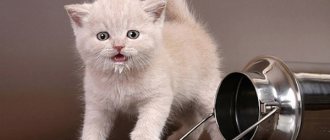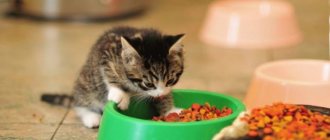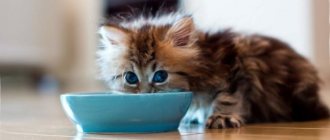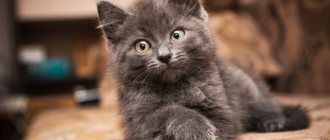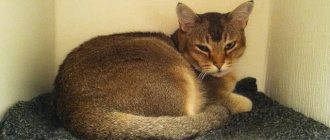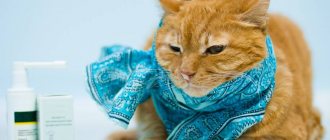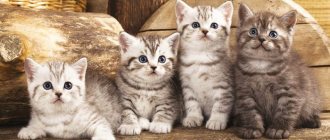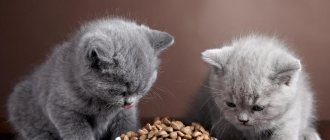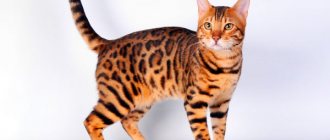How and what to feed a 2 month old kitten correctly? Usually, by the age of two months, the kitten stops sucking from the mother cat's breast or artificial formula through the pacifier. He is accustomed to lap up milk from a bowl on his own, and it’s time to introduce complementary foods. And here inexperienced owners are puzzled by the question: what can they feed a kitten at 2 months. The baby has recently been weaned from its mother, and therefore its immunity may quickly begin to weaken. To prevent this from happening, you need to choose a food that can replace cat milk and other formulas. The transition to solid food must be made gradually, otherwise the body will be harmed and the baby will experience stress.
How to choose a diet?
How correctly you feed your kitten at 2 months will determine whether your fluffy will grow into a big, energetic cat, or whether the little kitten will become a healthy mature cat. If the kitten does not like the food offered, he will stubbornly refuse it. This is a signal that you need to immediately change your diet and take a serious approach to creating a diet that will contain foods or feed containing useful microelements and vitamins. The main thing is that the food is healthy and that your pet likes it.
You need to immediately decide what you will feed your growing cat. You will have to choose one of three options:
- Natural nutrition.
- Ready-to-eat feed.
- Mixed nutrition.
No one can give you an exact answer which option is preferable. Even veterinary specialists have conflicting opinions on this issue. When choosing a suitable option, in any case, you will have to focus on your financial capabilities, the free time that you can or cannot devote to cooking and other aspects. An important role when choosing will be played by the breed of the kitten, its taste preferences, health status and even gender.
Ready-made dry food as an alternative for lazy cooks
Among the cat food on the market, it is customary to distinguish the following categories:
- economy class;
- premium class;
- super premium class;
- holistic
Advantages and disadvantages of feeding
The advantages of choosing specialized food are obvious:
- balanced diet;
- does not require cooking time;
- makes feeding easier when traveling;
- the required daily portion is not calculated, the information is given depending on the age and weight of the animal;
- a specific type of food is selected based on the cat’s breed, physiological needs, and for disease prevention;
- useful for small kittens for the development and stimulation of the jaw muscles.
The downside will be the choice of budget-class food, since it is made from waste products. Therefore, there is a possibility of clogging of the digestive tract. But expensive food also has disadvantages. The most significant is causing addiction in the animal. If it is necessary to transfer a cat to another type of food, problems arise. Another disadvantage is the cost of feed. The right decision when choosing a diet is an initial consultation with a veterinarian or a breeder of purebred cats.
An important condition is unlimited access to fresh and clean water.
Economy class food
The most affordable and accessible type of food due to the use of offal instead of meat. The main difference is various flavoring fillers, for example, chicken with vegetables, lamb, meat and the like. Some are skeptical about the composition, others choose it as an alternative to prepared food. There is no clear opinion, so the use of such feeds raises doubts. The composition of such a diet is not complete; you will need to provide the kitten with additional vitamins and minerals. Among the most famous are the following foods: Whiskas, Darling, Friskies, Rogue, Purina One, Stout, Cat Chow and others. For feeding up to a year, there are very few possible economy class foods; Friskies for kittens is common.
Premium kitten food
Better quality than budget food. A balanced diet, but also requiring additional minerals and vitamins. Flavor enhancers and preservatives are often used in cooking, which will not have a positive effect on the cat’s condition, but will not cause harm to health either. Premium food is usually purchased for outbred cats that do not require measures to prevent possible diseases. But no one forbids feeding purebred pets if you do not plan to participate in exhibitions. For two-month-old kittens, age-appropriate Purina ProPlan .
Super premium kitten food
Elite food is often chosen by breeders of expensive and elite breeds of cats. The pleasure is not cheap, but the level of quality is appropriate. Such food is produced taking into account the parameters of the pet: individually for each breed, to improve external signs, prevent diseases, active cats or those who love to walk outside. That is, it is possible to choose the right diet, taking into account the needs of the animal. This food is purchased in specialized stores. Suitable food for kittens: 1st Choice, Happy Cat Junior .
Holistics
Holistics belong to super premium , but today they are already classified as a separate group. It is believed that such a diet is balanced and of high quality among professional feeds. Popular brands: Acana, Farmina N&D, Carnilove, Go Natural, Grandorf and several others.
Diet options
canned and dry special food . Breeders will advise alternating these species if desired. For example, one month wet food, the next month feed dry food. Don't forget to change your pet's water.
Divide the daily food intake into the same 5-6 meals. How many grams per day to give is indicated on the package. Depending on the type of food, the daily dose also changes. For accurate information, it is better to consult a veterinarian. The amount of food per day depends on the breed, body weight of the kitten, physical condition and health.
Caring and attentive owners care about the health of their pet. Ready-made food does not mean worse, often the opposite.
By purchasing specialized food, the kitten is provided with a complete and balanced diet, which is so necessary for proper growth and formation.
Natural nutrition
Supporters of natural feeding of kittens are of the opinion that only it is safe and beneficial for the health of the baby. Therefore, when asked what to feed a kitten at 2 months old, they will answer that only homemade food is acceptable for babies. It is important to know that natural products are not the food you eat yourself, but food specially prepared for your cat from ingredients that are healthy for her, without chemical additives.
Advantages
- The main advantage of such nutrition is obvious - you independently choose fresh and high-quality products from which you cook. This means you can be sure that the food is beneficial for your kitten.
- Freshly prepared food does not contain any chemicals, therefore it is absolutely safe for a fragile body.
- The kitten receives a varied diet every day.
- Natural food does not cause dependence and painful addiction. One product can easily be replaced with another without causing stress in your pet.
Flaws
- You need to carefully ensure that prohibited foods that can harm the digestive system do not get into the grocery basket.
- With simple food, the kitten may not receive enough vitamins necessary for health.
- They need to be purchased separately and added to cat dishes, calculating the dosage yourself.
Regardless of which feeding method you choose for your baby, the basis of nutrition should be proteins - they are the ones that help “build” the body. Protein-rich foods should make up approximately 60% of the daily diet. Protein is found in large quantities in meat products and fish.
But in addition to protein foods, the kitten’s diet should also contain those that contain various microelements and beneficial vitamins. A growing body must receive sufficient amounts of calcium, which helps teeth grow and the bone skeleton develop. Your pet can get it from milk and fermented milk products. Once you know what to feed a two-month-old kitten and what to exclude from its diet, you can develop a complete diet that includes the necessary natural products.
Recommended Diet
First of all, in the second month of life, a predator kitten should be given lean meat every day - beef, chicken, turkey - ground ready or added to the broth, always well boiled, of course. The baby is not allowed any raw meat!
- for the development of the skeletal system and teeth, the diet must contain low-fat fermented milk products - kefir, fermented baked milk, yogurt without fruit additives;
- gradually introduce into the diet low-fat cottage cheese, natural, mashed with a small amount of low-fat sour cream, or ready-made store-bought for children;
- cereal and cereal porridges with milk, vegetable and meat broth (rice, buckwheat, oatmeal);
- fresh vegetables - carrots, pumpkin, white cabbage - raw, grated, or added to porridge and boiled in meat broth;
- lean boiled sea fish without bones is a source of phosphorus;
- sprouted grass (wheat sprouts, oats) and brewer's yeast for kittens;
- half a teaspoon of vegetable oil every 3 days.
Feeding with natural products
At two months the kitten switches to rough food. Therefore, the diet becomes varied. For both people and animals, it is necessary to follow a complete and balanced menu. When introducing a new ingredient, you should pay attention to the reaction of the animal’s body. Each pet is unique, so allergies or inability to digest one or another component of the menu are possible.
At the first suspicious symptoms (weakness or lethargy of the kitten, vomiting, fur began to fall out suddenly), it is better to contact a veterinarian to avoid unpleasant consequences.
The benefits of choosing natural food for kittens are obvious.
Firstly , fresh products are selected. The chances of unnecessary chemicals or harmful substances entering the body are minimized, which means the food will be safe.
Feeding 3 month old kittens
Feeding adult cats
Feeding a kitten at the age of 2 months
Secondly , diet diversity. Pamper your pet with something new every time.
Thirdly , such a food choice will not cause painful addiction, that is, there will be no development of addiction. You can safely replace foods with one another without causing stress to the kitten’s stomach.
Where there are pros, you can always find cons.
The disadvantages of this diet include the following:
- It is quite difficult to balance the food. The required amount of vitamins, minerals and trace elements for a growing body is required in large quantities. Therefore, for auxiliary nutrition, the missing supplements are purchased and added to the menu.
- Carefully monitor the quality of products to ensure that they do not contain anything dangerous or harmful to your pet’s digestive system.
Healthy eating from natural ingredients
Each new product should be introduced one at a time, gradually expanding and complicating the possible menu. The acceptable and safest foods for a kitten's diet are listed in the table.
| Products | Why are they useful? | In what form are they included in the diet? | Feeding frequency |
| Lean meat, for example: turkey or chicken, beef, rabbit. An alternative option would be canned children's meat that has already undergone the necessary processing for consumption. | Proteins of animal origin, so necessary for the growth and proper formation of a growing organism | Meat is added to the menu exclusively in boiled form, and for kittens it must be mechanically processed in a blender to the state of puree or small pieces. The skin is removed from poultry meat, since this is still too heavy food for the kitten’s developing body. | 4 times a week - 60-70% of the daily diet |
| Beef or chicken liver | Iron | It is given in the menu in boiled form | 1-2 times a week |
| By-products: heart, brains | Provide phosphorus | It is given in the menu in boiled form | 1-2 times a week |
| Chicken eggs | Protein for shiny and strong coat. Squirrels | Only the yolks of boiled eggs. Proteins are not digested | 1 time per week |
| Quail eggs | Boiled. Fresh ones are added to porridge | ||
| Porridge: rice, oatmeal, millet or buckwheat | Carbohydrates. Fiber for good digestion | Cooked in milk, vegetable or meat broth | 2 times per week |
| Low-fat sea fish | Phosphorus | Added to the diet boiled and deboned. | 1-2 times a week |
| Cottage cheese | Source of calcium for tooth growth, bone development | Mixed with low-fat sour cream | 1 time per week |
| Dairy products: milk, natural yogurt, fermented baked milk, kefir. Children's dairy products are used as an alternative | Does not replace water, give at room temperature | ||
| Cheese | For kittens it is used as a treat in small pieces | 1-3 times a week | |
| Fresh, raw or cooked vegetables: carrots, cucumbers, asparagus, beans, lettuce, zucchini, broccoli, celery | A storehouse of vitamins, microelements, fiber | Served separately or boiled. You can prepare assorted vegetable puree | 10% daily value |
| Fruits: melon, watermelon, apples, pear | Sources of vitamins and minerals | Used as a treat | 2-3 times a week |
| Sprouted oats or wheat | Vitamins, folic acid, microelements. Normalizes digestion | The container with sprouted grass is placed in a place accessible to the kitten, where it can be chewed at any convenient time. A bunch of grass is finely chopped with scissors for food. | 2-4 times a week |
| Vaseline oil | Normalization of digestion | Poured from a spoon or pipette into the pet's mouth | 2 times a week, half a teaspoon |
Diet preparation for kittens
A kitten's small stomach is ready to accommodate large amounts of food. At a young age, the kitten is not yet able to control its appetite. To avoid further problems, for example, not to stretch the stomach, it is recommended to divide the daily intake into five to six meals. A two-month-old cat eats 150-200 grams of food per kilogram of its own weight per day. Depending on the kitten’s health, the veterinarian will select the appropriate food.
A rational option would be to create a menu for the week. Then you get rid of the daily question: what to cook today. List the required ingredients by day of the week, adding missing vitamin supplements daily. Food is given at room temperature, uneaten leftovers are stored in the refrigerator until the next meal, but only for 24 hours. It is important to ensure that the kitten always has fresh water, preferably bottled, without unnecessary impurities.
What not to feed at two months
Wholesome and healthy food is the right choice for your beloved pet. But among the products it is worth highlighting some that cannot be given to a kitten for a number of reasons.
| Prohibited Products | Cause |
| Raw freshwater fish | Risk of helminth infection |
| Fatty dairy products | Disturbance of intestinal flora, obesity, digestive problems |
| Fatty meats, such as pork | |
| Smoked products: sausages, meat, lard | Excessive salt and fat content leads to stomach problems |
| Home and store preserves | Vinegar, salt, seasonings included in the composition will cause irreparable damage to digestion |
| Bones | The sharp ends of the bones scratch the larynx and esophagus, which leads to undesirable consequences |
| Whole milk | Cats lack the enzyme that breaks down whole milk. The product is not digestible by the stomach |
| Chocolate | Contains harmful substances that negatively affect the nervous system and heart. Consumption can lead to dehydration and even death. |
| Potato | Not digestible by the cat's body |
| Some vegetables and fruits: avocado, eggplant, onion, garlic, tomatoes | Toxic to animals |
| Sweets, flour products | Harmful due to sugar and yeast content |
| Salt, sugar, seasonings | Benefits - zero, only harm to health: caries, obesity, allergic reactions |
Summary
The diet of a two-month-old pet is not much different from the food of a child up to one year old. Choosing fresh food for your pet shows care and attention to the cat’s health. If you are ready to devote a sufficient amount of time to cooking, do not forget to add the necessary vitamins, and monitor proper nutrition, then a grateful cat will grow up healthy and full of vitality.
What should you not feed?
What you should not feed kittens at 2 months of age (and at other ages too):
- fatty meat - pork, lard, lard, goose - the sensitive little stomach will develop indigestion, and the liver will not cope;
- bones (the kitten can choke on them or damage the esophagus);
- whole milk (cats lack enzymes to digest milk);
- protein from a raw egg (the enzyme it contains has a destructive effect on biotin in the body);
- salted, smoked, peppered and canned foods for people;
- skin from chicken meat - it is not digested in the stomach;
- some vegetables (tomatoes, onions, garlic, eggplants) and fruits (avocado);
- chocolate (very toxic to cats and can cause premature death);
- vitamins and medicines for people with some exceptions.
Foods that should be kept to a minimum:
- peas and beans (cause bloating);
- freshwater fish (leads to infection with helminths, it is better to completely remove it from the diet).
Natural food
If it is decided that a 2-month-old kitten will receive food in the form of homemade food, it is important to understand that meals prepared for oneself will absolutely not be suitable, and it will be necessary to select an individual menu.
The baby's diet should be varied, natural (without chemicals) and always fresh, but even in this case, it may be necessary to separately introduce vitamins into the food.
So what kind of food should you prepare for your furry pet if the owner chose to feed the 2-month-old kitten homemade food? The choice here is not small, so if desired, it is quite possible to provide a newly-minted family member with a varied diet:
- boiled lean meat after freezing (beef, chicken, turkey, veal), which is best ground into minced meat or chopped as much as possible, since a 2-month-old kitten will not yet be able to handle large pieces;
- boiled low-fat sea fish, previously cleaned of bones and scales (useful, but you should not feed it to your baby more than 1-2 times a week);
- lactic acid products (cream, tender cottage cheese, natural yogurt, sour cream, etc.) are very useful for a growing body as a source of calcium;
- pureed vegetables (carrots, pumpkin, zucchini, cabbage) may not be appreciated by a 2-month-old kitten in their pure form, but adding them to porridges, minced meats or broths is usually welcomed or “not noticed” by babies;
- sprouted grass (oats, wheat) is useful not only for the vitamins it contains, but also helps cleanse the stomach of accumulated hair;
- egg yolk (the kitten will happily eat it, but 0.5 yolks per week will be enough) is an excellent “supplier” of vitamin E;
- vegetable oil (half a teaspoon per week) or brewer's yeast diluted in water will make the fur of the fluffy dog shiny.
It is also important to ensure an acceptable food temperature: the kitten should be fed lukewarm food, and in no case cold or hot!
© shutterstock
In addition to the recommended products, there are also those that are prohibited from feeding a 2-month-old kitten:
- any bones (this is fraught with gastrointestinal injuries);
- legumes (bloating);
- chicken skin (not digested in the stomach);
- whole milk (causes stomach upset and is not absorbed by the body);
- raw egg white (interferes with the absorption of vitamin B and can be a source of salmonella and E. coli, which are also dangerous for cats);
- fatty fish and meat (indigestion);
- smoked meats, salty and spicy foods, sausages;
- sweets;
- human vitamins;
- liver and kidneys in large quantities (in addition to the benefits, these filter organs already contain harmful waste);
- raw fish (a kitten can become infected with helminths from sick fish).
Important: if you have a Scottish kitten in your home, feeding it large quantities of foods containing calcium is also contraindicated (this can lead to strengthening of the ear cartilage and straightening of the shells).
Ready-made feed
The basic rule when feeding a 2-month-old kitten with ready-made food is to never mix dry and wet food. They will be digested by the body at different times, and it will be difficult for it to rebuild. If you have been using one type of food for a long time and want to switch to another, you need to do this carefully. Over the course of 8-10 days, gradually accustom your pet to a different type of preparation, introducing it into the diet in small portions and monitoring the reaction of the ward.
If you still combine 2 types of food, then 75% of the daily diet should be dry, and 25% wet.
pros
- High-quality food contains the optimal amount of healthy vitamins and minerals, no need to buy additional supplements.
- The composition is selected taking into account the age and physiological characteristics of the pet.
- The kitten will have to chew dry food, which will stimulate excellent jaw function.
- Saves time and effort on cooking.
- Convenient and easy to use. You can take the food with you on a trip.
- The daily dosage of food is indicated on the packaging.
Minuses
- Low-quality economy-class food is dangerous for animals due to its high content of mineral salts, the accumulation of which in the body leads to urolithiasis. In their production, production waste (animal fat, feathers, skin, etc.) is used, which clog the food tract. You will have to buy expensive food.
- Presence of fats, flavors and preservatives.
- Feed consumption is addictive. If necessary, it will be possible to wean a kitten off it only through a hunger strike.
Recommendations from veterinarians
If you decide to use ready-made food in your diet, but don’t know what to feed your 2-month-old kitten, your veterinarian’s advice will help you.
Professional breeders and veterinarians recommend buying ready-made food only in specialized stores or veterinary pharmacies. This should be premium and super-premium food, which contains all the nutrients that support life. The best ready-made dry food is considered to be holistic, the production technology of which preserves the juiciness and freshness of almost unprocessed meat, as well as the maximum benefit of the ingredients. The composition is detailed on the packages. And most importantly, such food marked “NaturCroq” is suitable for human consumption.
If we talk about specific foods for kittens, breeders often recommend the following brands:
Happy Cat Junior
Super premium dry food in the holistic category, specially designed for small kittens with sensitive stomachs from 5 weeks to 12 months
What's good:
- the composition includes the most healthy meat ingredients (beef, poultry, rabbit), as well as eggs and salmon;
- the texture and size of the food are selected in accordance with the kitten’s ability to cope with it;
1st Choice
Super-premium dry food (close in quality to holistic food) for babies from 2 to 12 months
What's good:
- excellent quality;
- affordable price for the level;
- a balanced selection of large quantities of meat and small quantities of plant ingredients;
- hypoallergenic;
- a nice addition is the inclusion of salmon fat (to improve brain activity, maintain heart and eye health).
Minuses:
- rarely found in stores, you need to place an online order on the Internet;
- Only 1 type has been developed.
Purina ProPlan
Dry food (1 option) for pets aged 6 weeks-1 year, premium wet food (2 types) up to 1 year.
What's good:
- low cost;
- availability in direct sale;
- the opportunity to save money when purchasing food in bulk;
- optimal content of nutrients and nutrients.
Minuses:
- the presence of plant ingredients in large quantities;
- possibility of allergies.
Features of specialized feeds
Such nutrition has many advantages, if you do not save money and focus on professional food - premium and super-premium class.
A high-quality manufacturer takes into account many cat characteristics - age, physiological, psychological; constitution, lifestyle and even gender. The gradation of dry food is very fractional. Food for purebred cats (British, Persian, Maine Coon, etc.) and others. For active and neutered animals. For the elderly and young. Not a single line is complete without dry and wet food for kittens 2 months and older. It contains more calcium, protein, and its own vitamin and mineral complex. Moreover, there is more than one feeding option for kittens. You can find dry food for kittens up to one year old; food for kittens from 1 month to 4 months, there are even dry milk formulas for babies in the transition period. Nice thing! There is no concern about what to feed a one-month-old kitten, let alone a 3-month-old kitten. There is no need to fuss with cereals and broths, calculate calories, buy supplements and vitamin preparations, or come up with a menu for tomorrow. Others did everything for you. Just follow their advice on how much your pet should eat.
How much should you feed a kitten?
On the back of the package you will always find a table with the daily intake. Standards may vary from one manufacturer to another, as may the composition of the feed.
By the way, about the composition. Be sure to watch it. The inventors of cheap mass-produced food use almost no meat. Its “analogue” is minced meat made from bones, skin and even feathers. They do not disdain dyes and flavors. In addition, our pets are fed too many mineral salts. The benefits of such nutrition are questionable, but the harm is obvious. Low-quality food has little nutritional value, it is worth feeding once, the animal requires more and more food, but most importantly, a bad product causes kidney and liver diseases. By saving on food, you will splurge on the veterinarian.
So, how much specialized food should a kitten eat per day? The quantity depends on the weight of the cat. The recommended diet is 75% dry food, 25% wet food. There will be no harm if the amount of wet food (pouch or jar) is half the daily dose. Often, racking their brains about what to feed their 1-month-old kittens, owners mix dry and wet food in one plate. We do not recommend doing this. Better give it separately. Ideally, wet food should be at a comfortable warm temperature. If you warm it up a little (up to 38-40 degrees), it becomes more fragrant.
For feeding, it is better to use a low, wide container that is comfortable for the kitten. Vitamin and mineral complexes, no supplements needed. Only in individual cases, on the advice of a veterinarian. Important! Your pet should always have access to a container of clean, not cold water. Dehydration is a deadly enemy. If a kitten eats dry food, its body definitely needs four times more moisture. Sometimes you hear that animals are smart! – find the liquid themselves. They climb into the bathtub or kitchen sink, lick water from the walls... Moisture with residues of household chemicals - is this really what you should feed your cat?
How many times a day should you feed?
Often, on average 5-6 times a day, in small portions. By six months, reduce to three times. Adult cats are recommended to be fed twice a day. In general, the diet is considered correct if the kitten is well-fed, but the skeleton is easily palpable, looks healthy, the coat is shiny, and the weight increases with growth.
Natural food: how to feed it correctly?
The saddest misconception when it comes to natural feeding is pieces from the master's table.
Our food is unacceptable for animals, especially children. Salt, in the amount we are used to, will be a fatal blow to their kidneys. Pepper, spices, without which almost none of our dishes are complete, is a dangerous trick for a small liver. Smoked, salty, spicy, sweet - should not be present on the kitten's table. This is a slow poison or a gun that will definitely fire in a few years - urolithiasis, enlarged liver, and more. Are you leaning towards natural foods? Approach this like an adult. A cat should grow up to be an omnivore, try different things, and not be stuck on one product. The argument that wild cats are mono-feeders in nature does not hold water. If rural hunters who catch mice meet the body's needs for protein, carbohydrates, vitamins, and minerals, then where will you get a fresh mouse for a city dweller?..
What can/should a kitten 3 months and younger eat?
- Meat, daily. Lean beef, chicken, turkey, rabbit. Boiled, raw or scalded. Cut into small pieces or ground into minced meat.
- Meat by-products: heart, liver, lungs, chicken stomachs. Ground or finely chopped, boiled or scalded.
- Milk, of course, every day. This is the basis of a child's diet. Later there will come a time when the body begins to poorly absorb this product. The teenager himself will refuse it. And for up to four months, this source of calcium is simply necessary.
- Fermented milk products: fermented baked milk, kefir, cottage cheese diluted with milk, low-fat sour cream.
- Fillet fish occasionally, no more than once a week. And only boiled. Raw fish (worms) and in large quantities (fluoride) are contraindicated.
- Eggs, quite often. Raw (whole, beating the yolk and white, or just the yolk) or boiled. Alone or with milk.
- Liquid porridge with milk or meat broth with the addition of meat. Oatmeal, oat flakes, buckwheat, rice, millet.
- Vegetables, raw and cooked. The kitten, of course, won’t bite the carrots, but you can crumble a little bit into meat pates and porridges. By the way, it is better not to use potatoes: starch is difficult to digest.
- A drop of vegetable oil a day to improve digestion.
- Ready-made vitamin and mineral complexes for kittens.
By the way, about the kitten, 1.5 months old. What to feed this baby? You can use ready-made baby food in jars – a mixture of meat and vegetables. Pates without salt, with vitamin supplements, are made from quality products.
What should you not feed your kitten (cat)?
- Pork (risk of contracting worms), fatty meat in general.
- Sharp, tubular bones (risk of injury, choking).
- Salty, spicy, smoked, fried, sweet, homemade canned food and sausage.
Delicious recipe from Vaska the cat
Milk, raw yolk, cottage cheese. Mix the ingredients by eye to get a thin porridge. A very useful, tasty little thing for a 2 month old kitten.
Mixed nutrition
Many experts insist that it is impossible to use both types of feeding at the same time - natural and feed, explaining their point of view by saying that the mixed type can lead to diseases of the digestive system and hypervitaminosis. Other veterinarians claim that this type of feeding is ideal for kittens at 2 months: by consuming natural products, the baby will receive all the necessary microelements from ready-made food.
With this method, it is better to consult a veterinarian about the exact dosage of feed. It will depend on the health status of the pet, its weight and breed. Some caring owners believe that after 2 weeks the diet of a two-month-old kitten needs to be changed. Nothing like that, if you are still tormented by the question of what to feed a kitten at 2.5 months, the answer is simple: the same thing as at 2 months.
Kitten diet
This article contains basic information that relates to compiling a kitten’s menu for a certain period of time, as well as general information on choosing the optimal diet.
Menu for a kitten for every day
Basic rules for feeding a kitten: - Always have a clean bowl. — The kitten is fed up to 5-6 times a day and at night for up to six months, then up to 4 times a day. — It’s better to feed at the same time every time. - Do not allow snacks between feedings.
Kittens are fed premium food specially designed for small animals.
If a natural diet is chosen, it should include lean meat (at least 50 grams per day), offal (3 times a week), fish (once a week), egg yolk (2 times a week), vegetables ( daily), cereals (daily), vitamin complexes, water.
Sample menu for a kitten for every day: 1. Breakfast: egg, cream, vitamins, sprouted cereals. 2. Second breakfast: cottage cheese with kefir and vitamins. 3. Lunch: chicken (50 g.) 4. Afternoon snack: beef meat (30 g), vegetable puree (30 g). 5. Dinner: buckwheat porridge with meat (10g).
Menu for a cat with a diseased liver
If a cat has a diseased liver, the diet should be dietary. Avoid fatty meat, cream, and sour cream. The diet consists of porridge (rolled oats, buckwheat), rice water. They add minced chicken or lean beef.
If the animal is not vomiting, give boiled potatoes and carrots.
You can transfer the animal to a special medicinal food for cats with a diseased liver.
Menu of British kittens up to a year
From three weeks of age, kittens require complementary feeding. It is introduced gradually, starting from 30 grams. per 1 kg. Animal weight (50g per day)
When the kitten is one month old, cottage cheese is added to the diet. Starting from 2-3 months, the animal is switched to special food for kittens or canned meat for children.
From 4-5 months, the diet is gradually replaced with dry food. By the age of six months, kittens are fed 3 times a day and include lean meat. By the age of one year, kittens are completely weaned off milk.
Natural food for kittens weekly menu
| Breakfast | 2 breakfast | Dinner | Dinner | |
| Monday | Cottage cheese, kefir, vitamins | Offal 40g. with greens | Vegetable puree, chicken meat 30g. | Buckwheat porridge with meat 10g. |
| Tuesday | Egg, kefir, vitamins | Chicken 40g. with greens | Vegetable puree, rabbit meat 30g. | Rice porridge with meat 10g. |
| Wednesday | Ryazhenka cheese, vitamins | By-products 40g with greens | Vegetable puree, beef meat 30g. | Semolina porridge with meat 10g. |
| Thursday | Cottage cheese, kefir, vitamins | Chicken with greens 40g | Vegetable puree, chicken meat 30g. | Oatmeal porridge with meat 10g. |
| Friday | Egg, cream, vitamins | Rabbit 40 gr. with greens | Vegetable puree, beef meat 30g. | Buckwheat porridge with meat 10g. |
| Saturday | Cottage cheese, kefir, vitamins | Offal 40g. with greens | Vegetable puree, rabbit meat 30g. | Oatmeal porridge with meat 10g. |
| Sunday | Cottage cheese, cream vitamins | Chicken 40g with greens | Vegetable puree, chicken meat 30g. | Rice porridge with meat 10g. |
Feeding Scottish kittens menu
The Scottish kitten's diet consists of meat (beef, chicken, rabbit, turkey), vegetables (up to 40% of the diet), cereals (15%), offal (liver), eggs, fish (once a week).
A feature of feeding this breed is control over the amount of calcium received.
When feeding dry food, choose premium or holistic food designed specifically for this breed of cat, then the owner will know for sure that his pet is receiving proper, balanced nutrition.
An approximate daily menu for Scottish kittens: 1. Breakfast: yolk, kefir, vitamins. 2. Second breakfast: chicken 40 gr., greens. 3. Lunch: beef 30g, vegetable puree 4. Afternoon snack: rice porridge with meat 5. Dinner: buckwheat porridge with meat.
Don Sphynx and Kuril Bobtail kitten menu by month
When feeding the Don Sphynx and Kuril Bobtail with natural food, the following needs of the animal are taken into account: food should be warm, fresh, and finely chopped. Complementary feeding begins at 3 weeks of age.
Start feeding with 1 teaspoon per meal. This could be special cat food or baby food. At 4 weeks, canned food is added, suitable for baby food. By 6 weeks, the feeding rate for 1 dose is 3-4 teaspoons, with five meals a day. The diet includes ground beef or chicken, canned meat, vegetable purees, and offal.
Every day, a kitten can be given 30 grams of raw beef, milk for up to 3 months, then kefir, cream, cottage cheese, sour cream, yogurt, porridge (rolled semolina, rice).
Several times a week they give boiled chicken and fish, egg yolk, cereals, vegetable purees, and herbs.
Kittens up to 8-10 months, sometimes up to a year, can be fed with special food for kittens, both dry and canned.
Diet of Maine Coon kittens
The diet of Maine Coon kittens from 1.5 months to a year is no different, only the volume of food increases and the frequency of feeding decreases.
Kittens that are less than a month old need a lot of milk. It is purchased in special stores. You can feed goat milk, first diluting it with water, then whole milk. The animal is fed 6 times a day.
Kittens over 1 month old are given milk porridge, meat and vegetables in their diet. Up to 4 months, kittens are fed 5 times a day.
The animal is 4-6 months old and needs to be fed four times a day. Proper nutrition must include chopped poultry giblets, vegetables, cottage cheese and whey.
From six months, the animal is switched to ready-made food or seafood and fermented milk products - kefir and fermented baked milk - are added to the diet. Any new product is introduced gradually, in small portions.
Add a comment Cancel reply
Feeding rules
- do not give your pet the entire daily portion at once: he is not yet able to control his appetite (with the exception of dry food);
- food from the refrigerator must be preheated so that it becomes warm;
- You can store food in the refrigerator for 24 hours, wet food for up to 2 days;
- add vitamins for cats to natural dishes;
- Your pet should always have a separate bowl full of fresh water, to which he has 24-hour access, otherwise he will start lapping up water wherever he can find it.
How to feed - rules
There are simple rules for feeding a two-month-old pet:
Give the daily portion of natural food in doses; the baby does not yet control his appetite. Dry food can be poured in immediately;
all food should be warm;
If the food was in the refrigerator, it is heated;
pre-cooked food should not be stored in the refrigerator for longer than 24 hours;
after opening, wet prepared food is stored for no more than two days;
If the food is natural, vitamins for cats are added to it.
Feeding regimen and norm
How many times a day and in what portions should a kitten be fed at 2 months? It is important that the kitten does not overeat, but also does not run around hungry, otherwise digestive problems will arise. Therefore, at 8-10 weeks, the fluffy baby needs to be fed often, but in small portions. It is best to divide the daily dose into 5-6 parts. The total weight of the daily portion will be approximately 150 g per 1 kg of the pet’s live weight, but it is better to check with a specialist. Experienced breeders recommend constantly diversifying the diet and drawing up a diet and feeding schedule for your pet in advance.
In the case of ready-made food, the dosage is always indicated on the packaging; you do not need to calculate it yourself.
Feeding regimen and portion size
Two-month-old kittens are fed 6 times a day. The baby should eat 160-180 g of natural products per day. Standards for dry granules, taking into account the weight of the animal, are indicated on the packaging.
Divide your daily intake into 6 equal portions or make 3 smaller portions and use them as snacks. Until six months, the pet is actively developing, gaining muscle mass. It is important to maintain a balance here: avoid overfeeding or starvation. Weigh your baby weekly to monitor changes in his weight.
Features of care
Small pets at 2 months are still very fragile creatures and are susceptible to various infections and parasites. It is necessary to especially carefully monitor their health, give them vaccinations at the right time, and carry out deworming. If you have any concerns or concerns regarding nutrition or health, please contact your veterinarian immediately. Observe the appearance and behavior of your pet: it should be well-fed with shiny fur and active in games. Particular attention should be paid to the constant availability of fresh water for the kitten, especially when feeding with industrial food.
Dry food for kittens that we do not recommend for daily feeding
| Name | Description |
| Hill's Science Plan Healthy Development | The composition is not the worst, there is quite a lot of high-quality protein, namely chicken and turkey flour. But in third place is corn. Corn protein is even less digestible by cats than wheat protein, only 54%. Moreover, pets get only 20-35% of their energy from carbohydrates; they get more than 40% of it from proteins. Therefore, corn should definitely not be the basis of a cat or kitten’s diet. |
| Josera Kitten | The composition, in addition to duck and turkey flour and duck fat, contains corn, rice and corn gluten. |
| Purina One for kittens | The composition is far from ideal. True, 17% chicken comes first, but even here we cannot be sure that this is meat, because... no specifications, followed by dried poultry protein, 14% whole wheat, animal fat, wheat and corn gluten, soy flour, pea protein concentrate, corn starch, dried chicory root, corn, etc. There is also no information on the percentage of components. |
| ProPlan Junior and Kitten | Contains corn and wheat gluten, rice, corn. In first and second place are 20% chicken and dried poultry protein. |
| Royal Canin | After the food was bought by the Mars company and it began to be produced in Russia instead of France, its quality dropped significantly. In other words, its composition is now very similar to economy, despite the presence of different lines, for example, for kittens there is a special milk replacer, food from 1 to 4 months, from 4 months to a year and for sterilized small cats. For example, the first ingredients in MOTHER&BABYCAT food are: dehydrated animal proteins (poultry), animal fats, rice, vegetable protein isolate, grain flour. So, nowhere is there any clarification about what kind of poultry is used, whether it is meat, what kind of rice, what vegetable protein is obtained from, what kind of grain. In general, the composition leaves much to be desired. |
| Cat Chow Kitten | The food is popular due to its affordable price. Reviews from cat owners are mostly positive, however, there are cases where the products provoked an allergic reaction. The composition contains a minimal amount of vitamins and minerals, so the kitten receives few useful elements. In addition, cereals come first. The diet does not contain harmful chemicals, dyes, or artificial flavors, so this is one of the best options among the economy segment, but you should not feed it on an ongoing basis. |
| Whiskas for kittens delicious pads with milk, turkey and carrots | Is a budget option. In the first place in the composition are wheat flour, poultry meal, turkey meal, meat and bone meal, rice, protein plant extracts, etc. The food cannot be used for daily feeding. |
